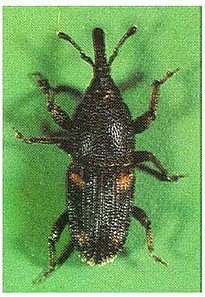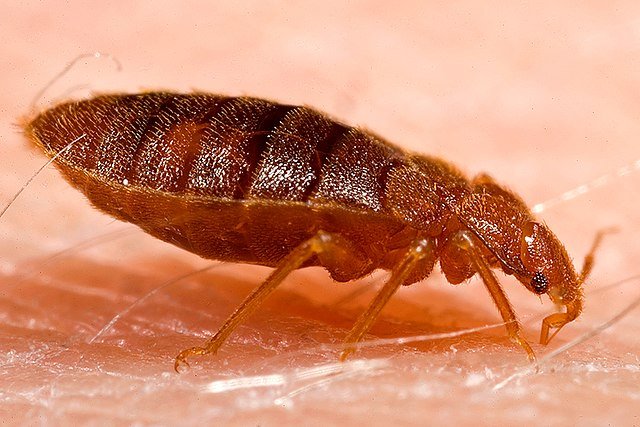Rice Weevil (Sitophilus oryzae): Identification, Risks, and Effective Control
 Few pests are as destructive to stored grains as the rice weevil (Sitophilus oryzae). This tiny insect is responsible for major post-harvest losses worldwide, attacking rice, wheat, maize, barley, rye, and other stored products. Unlike pantry moths or ants that infest open food, rice weevils actually live and breed inside whole grains, making infestations harder to detect until damage is advanced.
Few pests are as destructive to stored grains as the rice weevil (Sitophilus oryzae). This tiny insect is responsible for major post-harvest losses worldwide, attacking rice, wheat, maize, barley, rye, and other stored products. Unlike pantry moths or ants that infest open food, rice weevils actually live and breed inside whole grains, making infestations harder to detect until damage is advanced.
Rice weevils are not only a nuisance for homeowners who find them in bags of rice or flour, but also a serious economic problem for farmers, grain storage facilities, and food processors. Controlling them requires knowledge, vigilance, and sometimes professional treatment.
This article explains how to identify rice weevils, understand their biology, recognize the signs of infestation, and apply both household and professional control methods—including modern techniques like modified atmosphere storage.
Identification
Size: Adults are small, 2–3.5 mm long (about 1/8 inch).
Color: reddish-brown to black.
Markings: four light reddish or yellowish spots on the upper wings (elytra).
Shape: elongated snout (weevil “rostrum”) used for boring into grains.
Larvae: small, white, legless grubs hidden inside grains.
Behavior: can fly, allowing them to spread quickly between storage areas.
Because adults and larvae live inside grains, infestations are often hidden until grains show holes or powdery residue.
Biology and Lifecycle
Eggs: Females use their snout to bore a hole into a grain kernel and lay a single egg inside. The hole is sealed with a waxy plug, making it nearly invisible.
Larvae: develop entirely within the grain, feeding on the kernel.
Pupation: also occurs inside the grain.
Adults: emerge by chewing a circular exit hole. Adults live 4–5 months and females can lay up to 400 eggs.
Under warm, humid conditions, a full generation can be completed in just 4–6 weeks. This rapid reproduction allows infestations to explode in stored grain facilities.
Risks and Damage
Rice weevils do not bite humans or spread disease, but they cause significant losses:
Food contamination: infested rice, wheat, or maize is unfit for consumption.
Weight loss: heavy infestations can destroy a large percentage of stored grain.
Economic damage: global grain losses due to weevils and related pests run into millions of tons annually.
Spread: adults can fly to nearby storage sites, quickly infesting new areas.
In homes, rice weevils mean wasted bags of rice, flour, or pasta. In warehouses or silos, they represent serious economic threats.
Signs of Infestation
Small round exit holes in grains.
Powdery dust or frass in bags or bins.
Live weevils crawling in food containers or cupboards.
Adults flying near storage areas.
Grains that feel lighter or hollow when crushed.
Where They Are Found
Rice weevils are common worldwide, especially in warm and humid regions. They are found in:
Homes (pantries, kitchens, rice and flour packages).
Farms (grain silos, storage bins).
Food processing plants.
Warehouses and grain transport facilities.
Any place with stored whole grains can support rice weevil populations.
Control Methods
Household Control
Inspection: Check all grains, rice, pasta, cereals, and even dried beans.
Removal: Discard infested products immediately in sealed bags.
Storage: Keep new products in airtight containers (glass, metal, or heavy plastic).
Freezing: Small batches can be frozen at –18 °C (0 °F) for 4–7 days to kill all stages.
Heat treatment: Heating above 55 °C (131 °F) for an hour kills eggs, larvae, and adults.
Sanitation: Clean pantry shelves, vacuum cracks, and remove food residues.
Prevention Tips
Buy grains in small quantities to avoid long-term storage.
Store bulk grains in cool, dry, sealed containers.
Rotate food stock regularly.
Use bay leaves or natural repellents (limited effectiveness but may help).
Professional and Industrial Control
When rice weevils infest warehouses, silos, or large food processing areas, professional control is required. Methods include:
Fumigation: Phosphine gas or other approved fumigants penetrate grain masses and kill all life stages. This is effective but must be performed by licensed professionals due to safety risks.
Modified Atmosphere (Controlled Atmosphere): Oxygen is reduced and replaced with high concentrations of carbon dioxide (CO₂) or nitrogen. Without oxygen, weevils die at all stages. This is a safe, residue-free method often used in organic grain storage.
Temperature control: Chilling grain below 15 °C (59 °F) halts weevil development. Heating can also be used in some facilities.
Inert dusts: Diatomaceous earth or silica dust applied to grain can physically damage and kill insects.
Integrated Pest Management (IPM): Combines sanitation, monitoring (traps), stock rotation, temperature control, and targeted chemical or atmosphere treatments when necessary.
These methods are essential for commercial operations, where even a small infestation can spread to thousands of tons of grain.
FAQ
Q: Do rice weevils only infest rice?
A: No, they attack many grains—wheat, maize, barley, rye, oats, and even pasta or dried beans.
Q: Can rice weevils infest packaged food?
A: Yes, especially if packaging is not airtight. They can chew through paper, thin cardboard, and plastic bags.
Q: Can I eat rice with weevils?
A: It is not recommended. Infested grains are contaminated with insect waste and are often hollow.
Q: Do rice weevils die in the fridge?
A: Refrigeration slows them down but does not kill them. Freezing is necessary.
Q: Are rice weevils dangerous to health?
A: They do not spread disease but make food unsafe and unpleasant to eat.
Final Thoughts
Rice weevils are among the most destructive stored-product pests worldwide. For households, the key is prevention: airtight containers, freezing small batches, and quick removal of infested food. For farmers, warehouses, and food industries, professional methods like fumigation, modified atmosphere, and IPM are essential to prevent large-scale losses.
Understanding their biology and habits is the best weapon. Once you know how rice weevils live and reproduce, you can take the right steps to protect both your food and your business.
Read more in our blog and explore guides on many other enemies. Stay informed.
Disclaimer
This article is for informational purposes only. Pest control laws and approved chemicals vary by country. For best results and legal safety, we strongly recommend contacting a licensed pest control professional in your local area. Always make sure that the pest control technician is properly certified or licensed, depending on your country’s regulations. It’s important to confirm that they only use approved products and apply them exactly as instructed on the product label. In most places in Europe, UK, or USA, following label directions is not just best practice—it’s the law.
Author
Nasos Iliopoulos
MSc Agronomist & Certified Pest Control Expert
Scientific Director, Advance Services (Athens, Greece)
Licensed Pest Control Business – Ministry of Rural Development & Food (GR)
References
Wikipedia – What is rice Weevil
Oklahoma State University extension – Rice Weevils insect

